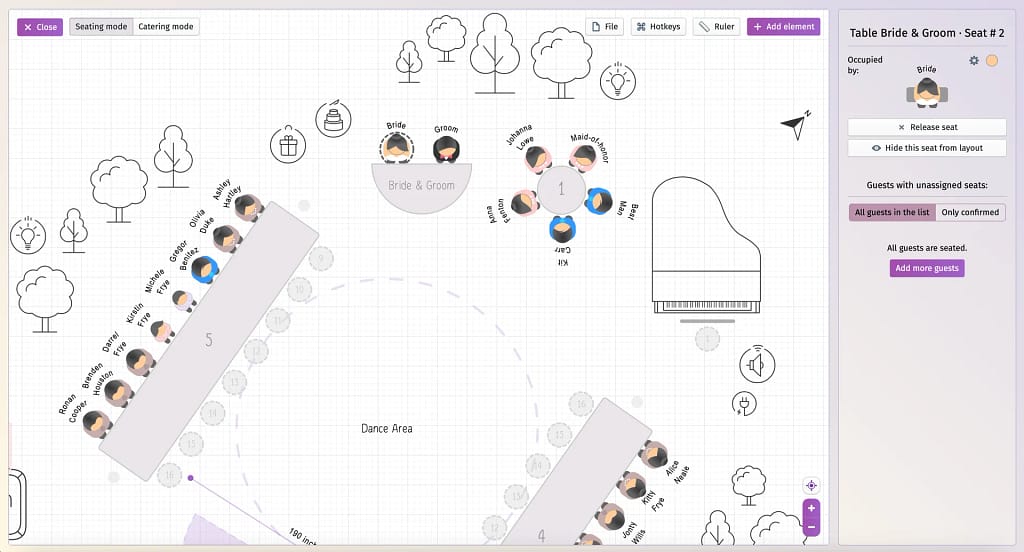Last Updated on October 9, 2024 by SampleBoard
Planning your wedding can feel like a puzzle with a thousand pieces, each as crucial as the next.
One piece that often stumps couples is the seating chart.
Should you assign tables, leave them open, or even assign each seat?
The decision on whether to have a seating chart at your wedding reception is personal yet important.
It's a choice that can significantly influence the atmosphere of your event and the interactions among your guests.
In this blog, we'll thoroughly examine the pros and cons of a seating chart, from the formal ambiance it can create to the control it offers over guest dynamics.
We'll also touch on the potential drawbacks, such as the time-consuming nature of planning a seating chart and the potential for uninvited guests.
Whether you're planning a minimalist wedding or a grand affair, understanding the implications of your seating arrangement can help you make an informed decision.
So, buckle up, and let's navigate the world of wedding reception seating together.

Wedding planning can be daunting, especially when deciding on a seating arrangement. Couples often struggle with having a seating chart or letting guests choose their seats.
In this section, we'll explore the pros and cons of wedding seating arrangements, providing a comprehensive analysis to help you make an informed decision.
A seating chart can be a practical solution for ensuring everyone has a place to sit and avoiding potential conflicts.
However, it's not without its drawbacks. Let's explore these aspects in detail.
Avoids Confusion:
Having a seating chart or assigned tables eliminates the chaos of guests scrambling to find a seat. It prevents potential traffic jams from people trying to find a table closest to the buffet or the dance floor.
Keeps Groups Together:
With a seating arrangement, guests can sit next to the people they came with. This prevents the awkward situation of splitting up couples or friends due to a lack of open seats.
Maximizes Venue Space:
Planning the seating arrangements ensures you're making the most of your venue space. You can fill tables completely and ensure that there are no empty seats.
Simplifies Waitstaff's Work:
If you have a plated dinner service, a seating chart simplifies the work of the waitstaff. They will know in advance where to take the grilled salmon and where to take the filet mignon.
Enhances Guest Experience:
You know your guests: the social butterflies, the shy ones, the ones who do (and don't) get along. With a seating chart, you can strategically place people in certain spots to create a great guest experience.
Uninvited Guests:
A seating chart doesn't account for unexpected guests. Some people could be better at RSVPing or do it at the last minute. What if you have a seating chart and someone shows up unannounced?
Time-Consuming:
Planning a seating arrangement can be very stressful and time-consuming. To properly plan a seating chart, you must rely on all your guests RSVPing, which can be difficult.
Potential Unhappiness:
If your guests are unhappy with who they are sitting with, this could cause unwanted unhappiness. It's crucial to think about who is sitting where when arranging.
Perceived Favoritism:
Some guests may think you're picking favorites when creating a seating chart.
This might create resentment and distrust, which could be detrimental to the overall atmosphere of your wedding reception.
Amid the chaos of wedding planning, creating the seating chart can often seem overwhelming.
However, it can be a breeze with the right wedding seating chart assistant.
These tools help you organize your guest list, assign seats, and seamlessly share your seating plan with vendors.
Whether seating close friends at the head table or arranging the wedding party, these tools streamline the process and eliminate stress.
Offering a simple, organized method to track your guest list and their assigned seats, these assistants make it easy to make changes, add notes, and collaborate with others involved in the planning.
This is particularly useful for communicating seating arrangements with vendors.
You can include essential details like special needs and meal preferences for each guest, ensuring everyone is accommodated.
Last-minute changes are no problem—you can quickly update the chart and distribute the new version effortlessly.
In short, online tools are invaluable for creating your wedding seating chart. They make the process efficient and stress-free, giving you more time to enjoy your special day.
The decision to have a seating chart at your wedding reception is personal, with pros and cons to consider.
Remember, the ultimate goal is to create an enjoyable and memorable experience for everyone.
Whether you opt for a seating chart or a more relaxed approach, the key is to consider your guests' comfort and the overall atmosphere you want to create.
In the end, it's your special day.
So, choose what feels suitable for you and your partner. Whether you decide on a seating chart or not, your wedding will be a beautiful celebration of your love.